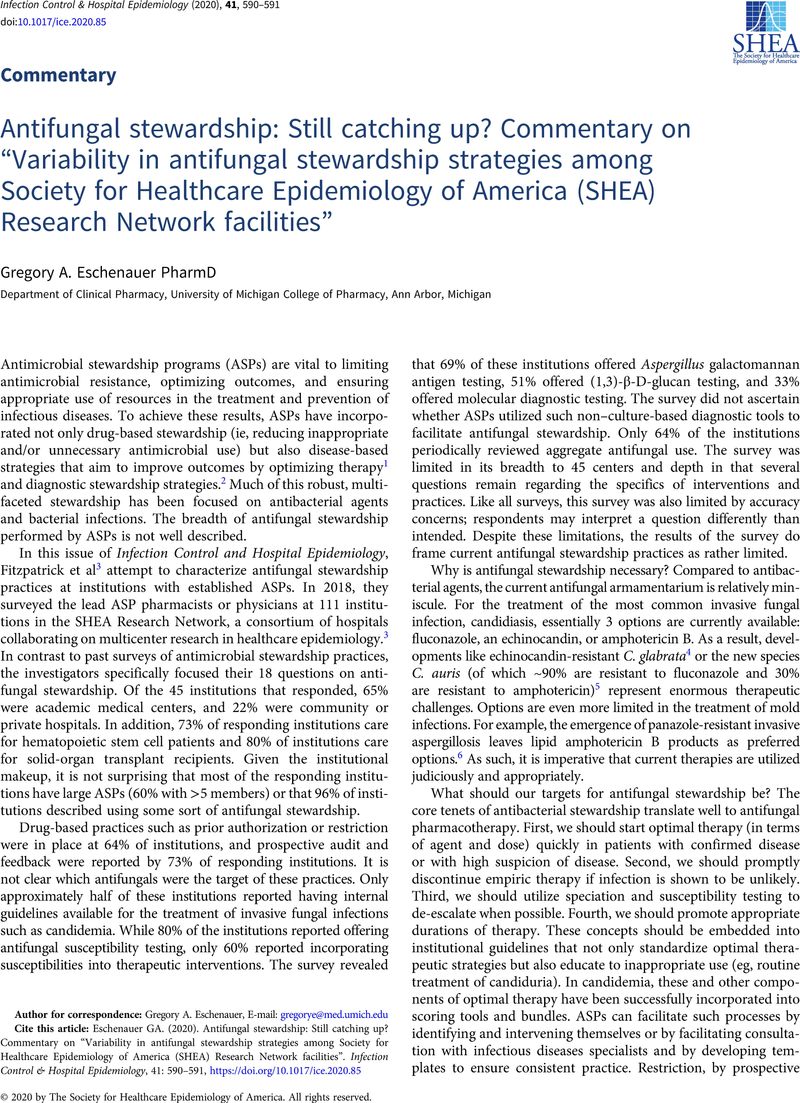No CrossRef data available.
Article contents
Antifungal stewardship: Still catching up? Commentary on “Variability in antifungal stewardship strategies among Society for Healthcare Epidemiology of America (SHEA) Research Network facilities”
Published online by Cambridge University Press: 04 May 2020
Abstract
An abstract is not available for this content so a preview has been provided. Please use the Get access link above for information on how to access this content.

- Type
- Commentary
- Information
- Copyright
- © 2020 by The Society for Healthcare Epidemiology of America. All rights reserved
References
Foolad, F, Nagel, JL, Eschenauer, G, Patel, TS, Nguyen, CT. Disease-based antimicrobial stewardship: a review of active and passive approaches to patient management. J Antimicrob Chemother 2017;72:
3232–3244.CrossRefGoogle ScholarPubMed
Morgan, DJ, Malani, P, Diekema, DJ. Diagnostic stewardship—leveraging the laboratory to improve antimicrobial use. JAMA 2017;318:607–608.CrossRefGoogle ScholarPubMed
Fitzpatrick, MA, Albarillo, F, Santarossa, M, Evans, CT, Suda, KJ. Variability in antifungal stewardship strategies among Society for Healthcare Epidemiology of America (SHEA) Research Network facilities. Infect Control Hospital Epidemiol 2020; [Online ahead of print]CrossRefGoogle ScholarPubMed
Ostrosky-Zeichner, L.
Candida glabrata and FKS mutations: witnessing the emergence of the true multidrug-resistant Candida
. Clin Infect Dis 2013; 56:1733–1734.CrossRefGoogle ScholarPubMed
Lestrade, PP, Bentvelsen, RG, Schauwvlieghe, AFAD, et al. Voriconazole resistance and mortality in invasive aspergillosis: a multicenter retrospective cohort study. Clin Infect Dis 2019;68:1463–1471.CrossRefGoogle ScholarPubMed
Bienvenu, AL, Argaud, L, Aubrun, F, et al. A systematic review of interventions and performance measures for antifungal stewardship programmes.
J Antimicrob Chemother 2018;73:297–305.CrossRefGoogle ScholarPubMed
Garey, KW, Neuhauser, MM, Bearden, DT, et al. Evaluation of antifungals in the surgical intensive care unit: a multi-institutional study. Mycoses 2006; 49:226–231.CrossRefGoogle ScholarPubMed
Siddharthan, T, Karakousis, PC, Checkley, W. Empirical antifungal therapy in critically ill patients with sepsis. Another case of less is more in the ICU. JAMA 2016;316:1549–1550.CrossRefGoogle ScholarPubMed
Gill, CM, Kenney, RM, Hencken, L, et al. T2 Candida versus beta-D-glucan to facilitate antifungal discontinuation in the intensive care unit. Diagn Microbiol Infect Dis 2019;95:162–165.CrossRefGoogle ScholarPubMed
De Pauw, BE, Donnelly, JP. Prophylaxis and aspergillosis—has the principle been proven? N Engl J Med 2007;356:409–411.CrossRefGoogle ScholarPubMed
Patel, TS, Eschenauer, GA, Stuckey, LJ, Carver, PL. Antifungal prophylaxis in lung transplant recipients. Transplantation 2016;100:1815–1826.CrossRefGoogle ScholarPubMed
Chamilos, G, Lionakis, MS, Kontoyiannis, DP. Call for action: invasive fungal infections associated with ibrutinib and other small molecule kinase inhibitors targeting immune signaling pathways. Clin Infect Dis 2018;66:
140–148.CrossRefGoogle ScholarPubMed
Haidar, G, Dorritie, K, Farah, R, Bogdanovich, T, Nguyen, MH, Samanta, P. Invasive mold infections after chimeric antigen receptor-modified T-cell therapy: a case series, review of the literature, and implications for prophylaxis. Clin Infect Dis 2019. doi: 10.1093/cid/ciz1127.Google Scholar




